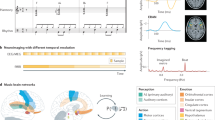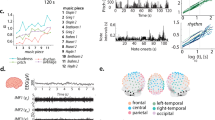Abstract
Studies of experience-driven neuroplasticity at the behavioural, ensemble, cellular and molecular levels have shown that the structure and significance of the eliciting stimulus can determine the neural changes that result. Studying such effects in humans is difficult, but professional musicians represent an ideal model in which to investigate plastic changes in the human brain. There are two advantages to studying plasticity in musicians: the complexity of the eliciting stimulus — music — and the extent of their exposure to this stimulus. Here, we focus on the functional and anatomical differences that have been detected in musicians by modern neuroimaging methods.
This is a preview of subscription content, access via your institution
Access options
Subscribe to this journal
Receive 12 print issues and online access
$189.00 per year
only $15.75 per issue
Buy this article
- Purchase on Springer Link
- Instant access to full article PDF
Prices may be subject to local taxes which are calculated during checkout




Similar content being viewed by others
References
Kilgard, M. P. et al. Sensory input directs spatial and temporal plasticity in primary auditory cortex. J. Neurophysiol. 86, 326–338 (2001).
Singer, W. Development and plasticity of cortical processing architectures. Science 270, 758–764 (1995).
Recanzone, G. H., Merzenich, M. M., Jenkins, W. M., Grajski, K. A. & Dinse, H. R. Topographic reorganization of the hand representation in cortical area 3b of owl monkeys trained in a frequency-discrimination task. J. Neurophysiol. 67, 1031–1056 (1992).
Ahissar, M. & Hochstein, S. Task difficulty and the specificity of perceptual learning. Nature 387, 401–406 (1997).
Anderson, B. J. et al. Glial hypertrophy is associated with synaptogenesis following motor-skill learning, but not with angiogenesis following exercise. Glia 11, 73–80 (1994).
van Praag, H., Kempermann, G. & Gage, F. H. Neural consequences of environmental enrichment. Nature Rev. Neurosci. 1, 191–198 (2000).
Röder, B. et al. Improved auditory spatial tuning in blind humans. Nature 400, 162–166 (1999).
Bavelier, D. et al. Visual attention to the periphery is enhanced in congenitally deaf individuals. J. Neurosci. 20, RC93 (2000).
Bavelier, D. & Neville, H. J. Cross-modal plasticity: where and how? Nature Rev. Neurosci. 3 , 443 –452 (2002 ).
Flor, H. et al. Phantom-limb pain as a perceptual correlate of cortical reorganization following arm amputation. Nature 375, 482–484 (1995).
Schuppert, M., Münte, T. F., Wieringa, B. M. & Altenmüller, E. Receptive amusia: evidence for cross-hemispheric neural networks underlying music processing strategies. Brain 123, 546–559 (2000).
Lim, V. K., Altenmüller, E. & Bradshaw, J. L. Focal dystonia: current theories. Hum. Mov. Sci. 20, 875–914 (2001).
Elbert, T. et al. Alteration of digital representations in somatosensory cortex in focal hand dystonia. Neuroreport 9, 3571–3575 (1998).
Elbert, T., Pantev, C., Wienbruch, C., Rockstroh, B. & Taub, E. Increased cortical representation of the fingers of the left hand in string players. Science 270, 305–307 (1995).
Pantev, C. et al. Increased auditory cortical representation in musicians. Nature 392, 811–814 (1998).
Pantev, C., Roberts, L. E., Schulz, M., Engelien, A. & Ross, B. Timbre-specific enhancement of auditory cortical representations in musicians. Neuroreport 12, 169–174 (2001).
Picton, T. W., Alain, C., Otten, L., Ritter, W. & Achim, A. Mismatch negativity: different water in the same river. Audiol. Neurootol. 5, 111–139 (2000).
Russeler, J., Altenmüller, E., Nager, W., Kohlmetz, C. & Münte, T. F. Event-related brain potentials to sound omissions differ in musicians and non-musicians. Neurosci. Lett. 308, 33–36 (2001).
Koelsch, S., Schroger, E. & Tervaniemi, M. Superior pre-attentive auditory processing in musicians. Neuroreport 10, 1309–1313 (1999).
Tervaniemi, M., Rytkonen, M., Schroger, E., Ilmoniemi, R. J. & Näätänen, R. Superior formation of cortical memory traces for melodic patterns in musicians. Learn. Mem. 8, 295–300 (2001).
Tiitinen, H. et al. Tonotopic auditory cortex and the magnetoencephalographic (MEG) equivalent of the mismatch negativity. Psychophysiology 30, 537–540 (1993).
Tervaniemi, M. et al. Functional specialization of the human auditory cortex in processing phonetic and musical sounds: a magnetoencephalographic (MEG) study. Neuroimage 9, 330–336 (1999).
Regnault, P., Bigand, E. & Besson, M. Different brain mechanisms mediate sensitivity to sensory consonance and harmonic context: evidence from auditory event-related brain potentials. J. Cogn. Neurosci. 13, 241–255 (2001).
Tramo, M. J., Cariani, P. A., Delgutte, B. & Braida, L. D. Neurobiological foundations for the theory of harmony in western tonal music. Ann. NY Acad. Sci. 930, 92–116 (2001).
Hillyard, S. A., Teder-Salejarvi, W. A. & Münte, T. F. Temporal dynamics of early perceptual processing. Curr. Opin. Neurobiol. 8, 202–210 (1998).
Münte, T. F., Nager, W., Rosenthal, O., Johannes, S. & Altenmüller, E. in Integrated Human Brain Science (ed. Nakada, T.) 389–398 (Elsevier, Amsterdam, 2000).
Musicant, A. D., Chan, J. C. & Hind, J. E. Direction-dependent spectral properties of cat external ear: new data and cross-species comparisons. J. Acoust. Soc. Am. 87, 757–781 (1990).
Münte, T. F., Kohlmetz, C., Nager, W. & Altenmüller, E. Neuroperception. Superior auditory spatial tuning in conductors. Nature 409, 580 (2001).
Meyer, A. in Music and the Brain (eds Macdonald, C. & Henson, R. A.) 255–281 (Heinemann Medical Books, London, 1977).
Jäncke, L., Schlaug, G., Huang, Y. & Steinmetz, H. Asymmetry of the planum parietale. Neuroreport 5, 1161–1163 (1994).
Schlaug, G., Jäncke, L., Huang, Y. & Steinmetz, H. In vivo evidence of structural brain asymmetry in musicians. Science 267, 699–701 (1995).
Keenan, J. P., Thangaraj, V., Halpern, A. R. & Schlaug, G. Absolute pitch and planum temporale. Neuroimage 14, 1402–1408 (2001).
Zatorre, R. J., Perry, D. W., Beckett, C. A., Westbury, C. F. & Evans, A. C. Functional anatomy of musical processing in listeners with absolute pitch and relative pitch. Proc. Natl Acad. Sci. USA 95, 3172–3177 (1998).
Amunts, K. et al. Hand skills covary with the size of motor cortex: a macrostructural adaptation. Hum. Brain Mapp. 5, 206–215 (1997).
Jäncke, L., Schlaug, G. & Steinmetz, H. Hand skill asymmetry in professional musicians. Brain Cogn. 34, 424–432 (1997).
Schlaug, G., Jäncke, L., Huang, Y., Staiger, J. F. & Steinmetz, H. Increased corpus callosum size in musicians. Neuropsychologia 33, 1047–1055 (1995).
Aboitiz, F., Scheibel, A. B., Fisher, R. S. & Zaidel, E. Fiber composition of the human corpus callosum. Brain Res. 598, 143–153 (1992).
Ridding, M. C., Brouwer, B. & Nordstrom, M. A. Reduced interhemispheric inhibition in musicians. Exp. Brain Res. 133, 249–253 (2000).
Schlaug, G. The brain of musicians. A model for functional and structural adaptation. Ann. NY Acad. Sci. 930, 281–299 (2001).
Ashburner, J. & Friston, K. J. Voxel-based morphometry — the methods. Neuroimage 11, 805–821 (2000).
Gaser, C. & Schlaug, G. Brain structures differ between musicians and non-musicians. Neuroimage 13, 1168 (2001).
Karni, A. et al. The acquisition of skilled motor performance: fast and slow experience-driven changes in primary motor cortex. Proc. Natl Acad. Sci. USA 95, 861–868 (1998).
Karni, A. et al. Functional MRI evidence for adult motor cortex plasticity during motor skill learning. Nature 377, 155–158 (1995).
Hund-Georgiadis, M. & von Cramon, D. Y. Motor-learning-related changes in piano players and non-musicians revealed by functional magnetic-resonance signals. Exp. Brain Res. 125, 417–425 (1999).
Jäncke, L., Shah, N. J. & Peters, M. Cortical activations in primary and secondary motor areas for complex bimanual movements in professional pianists. Brain Res. Cogn. Brain Res. 10, 177–183 (2000).
Krings, T. et al. Cortical activation patterns during complex motor tasks in piano players and control subjects. A functional magnetic resonance imaging study. Neurosci. Lett. 278, 189–193 (2000).
Pascual-Leone, A. The brain that plays music and is changed by it. Ann. NY Acad. Sci. 930, 315–329 (2001).
Bangert, M., Haeusler, U. & Altenmüller, E. On practice: how the brain connects piano keys and piano sounds. Ann. NY Acad. Sci. 930, 425–428 (2001).
Haueisen, J. & Knosche, T. R. Involuntary motor activity in pianists evoked by music perception. J. Cogn. Neurosci. 13, 786–792 (2001).
Umilta, M. A. et al. I know what you are doing. A neurophysiological study. Neuron 31, 155–165 (2001).
Schumann, R. Tagebücher, Band 1 (Stroemfeld Roter Stern, Basel, 1971).
Byl, N. N., McKenzie, A. & Nagarajan, S. S. Differences in somatosensory hand organization in a healthy flutist and a flutist with focal hand dystonia: a case report. J. Hand Ther. 13, 302–309 (2000).
Sanger, T. D., Tarsy, D. & Pascual-Leone, A. Abnormalities of spatial and temporal sensory discrimination in writer's cramp. Mov. Disord. 16, 94–99 (2001).
Sanger, T. D., Pascual-Leone, A., Tarsy, D. & Schlaug, G. Nonlinear sensory cortex response to simultaneous tactile stimuli in writer's cramp. Mov. Disord. 17, 105–111 (2002).
Byl, N. N., Merzenich, M. M. & Jenkins, W. M. A primate genesis model of focal dystonia and repetitive strain injury. I. Learning-induced dedifferentiation of the representation of the hand in the primary somatosensory cortex in adult monkeys. Neurology 47, 508–520 (1996).
Pujol, J. et al. Brain cortical activation during guitar-induced hand dystonia studied by functional MRI. Neuroimage 12, 257–267 (2000).
Polat, U. & Sagi, D. Spatial interactions in human vision: from near to far via experience-dependent cascades of connections. Proc. Natl Acad. Sci. USA 91, 1206–1209 (1994).
Jacobs, K. M. & Donoghue, J. P. Reshaping the cortical motor map by unmasking latent intracortical connections. Science 251, 944–947 (1991).
Noppeney, U., Waberski, T. D., Gobbele, R. & Buchner, H. Spatial attention modulates the cortical somatosensory representation of the digits in humans. Neuroreport 10, 3137–3141 (1999).
Maguire, E. A. et al. Navigation-related structural change in the hippocampi of taxi drivers. Proc. Natl Acad. Sci. USA 97, 4398–4403 (2000).
Blood, A. J. & Zatorre, R. J. Intensely pleasurable responses to music correlate with activity in brain regions implicated in reward and emotion. Proc. Natl Acad. Sci. USA 98, 11818–11823 (2001).
Profita, J. & Bidder, T. G. Perfect pitch. Am. J. Med. Genet. 29, 763–771 (1988).
Baharloo, S., Johnston, P. A., Service, S. K., Gitschier, J. & Freimer, N. B. Absolute pitch: an approach for identification of genetic and nongenetic components. Am. J. Hum. Genet. 62, 224–231 (1998).
Revesz, G. Introduction to the Psychology of Music (Longmans Green, London, 1953).
Baharloo, S., Service, S. K., Risch, N., Gitschier, J. & Freimer, N. B. Familial aggregation of absolute pitch. Am. J. Hum. Genet. 67, 755–758 (2000).
Gregersen, P. K., Kowalsky, E., Kohn, N. & Marvin, E. W. Absolute pitch: prevalence, ethnic variation, and estimation of the genetic component. Am. J. Hum. Genet. 65, 911–913 (1999).
Ohnishi, T. et al. Functional anatomy of musical perception in musicians. Cereb. Cortex 11, 754–760 (2001).
Crummer, G. C., Walton, J. P., Wayman, J. W., Hantz, E. C. & Frisina, R. D. Neural processing of musical timbre by musicians, nonmusicians, and musicians possessing absolute pitch. J. Acoust. Soc. Am. 95, 2720–2727 (1994).
Klein, M., Coles, M. G. H. & Donchin, E. People with absolute pitch process tones without producing a P300. Science 233, 1306–1309 (1984).
Author information
Authors and Affiliations
Corresponding author
Related links
Related links
FURTHER INFORMATION
Encyclopedia of Life Sciences
brain imaging: observing ongoing neural activity
cortical plasticity: use-dependent remodelling
MIT Encyclopedia of Cognitive Sciences
Rights and permissions
About this article
Cite this article
Münte, T., Altenmüller, E. & Jäncke, L. The musician's brain as a model of neuroplasticity. Nat Rev Neurosci 3, 473–478 (2002). https://doi.org/10.1038/nrn843
Issue Date:
DOI: https://doi.org/10.1038/nrn843
This article is cited by
-
NSF DARE—transforming modeling in neurorehabilitation: a patient-in-the-loop framework
Journal of NeuroEngineering and Rehabilitation (2024)
-
Developmental, Behavioural and NDBI Interventions in Autistic Children or at Elevated Likelihood of Autism: A Systematic Review of Neural Outcomes
Review Journal of Autism and Developmental Disorders (2024)
-
Bimanual finger coordination in professional and amateur darbuka players
Experimental Brain Research (2023)
-
Exercise alters cortico-basal ganglia network metabolic connectivity: a mesoscopic level analysis informed by anatomic parcellation defined in the mouse brain connectome
Brain Structure and Function (2023)
-
The plyometric activity as a conditioning to enhance strength and precision of the finger movements in pianists
Scientific Reports (2022)



